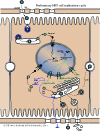Budding and exit
HBV production rates are relatively low. It has been estimated that one hepatocyte releases 1 to 10 viruses per day in vivo during the productive phase of infection (Nowak et al. 1996) Rating=2.
After maturation, capsids move to the post-endoplasmic reticulum (ER) membranes near the pre-Golgi where they interact with the cytosolic pre-S1 domain of LHB (Liou et al. 2008) Rating=1. Interaction with this domain mediates envelopment, this domain acting as a matrix (Bruss 2004) Rating=review, (Le seyec et al. 1999), (Loffler-Mary et al. 2000) Rating=2. Both SHB and LHB are required for envelopment (Bruss et al. 1991) Rating=1. LHB contains a cytoplasmic retention signal which inhibits its secretion. Binding to the capsid must therefore suppress this inhibition to allow budding (Bruss et al. 1999) Rating=1.
Budding of HBV from the endoplasmic reticulum (ER)/pre-Golgi membranes requires the host cellular multivesicular body functions and thus probably involves interactions with the Endosomal Sorting Complex
Required for Transport (ESCRT) network (Watanabe et al. 2007) Rating=2,
(Lambert et al. 2007) Rating=2. The ESCRT system, normally used by the cell among others to drive vesicularization into the endosome (Wollert et al. 2010) Review, could be hijacked by HBV to help in membrane budding and/or membrane scission at the ER, thereby generating vesicles containing the enveloped virus.
Several viruses, such as retroviruses, herpes simplex virus-1 and hepatitis C virus, use the ESCRT network at one point during budding (Tamai et al. 2011) Rating=2, (Pawliczek et al. 2009) Rating=2, (Martin-Serrano et al. 2011) Review,
(Chen et al. 2008) Review.
Bardens et al. have suggested that naked capsids could bud through Alix protein, but independently of ESCRT (Bardens et al. 2011) Rating=1
Finally, HBV is probably exported baso-laterally by polarity-dependent mechanisms (Bhat et al. 2011) Rating=2
Lipid rafts might be involved in HBV release (Xie et al. 2011) Rating=0, which could be linked to the observed export in association with sphingolipid structures (Bhat et al. 2011) Rating=1 and an estimated high cholesterol content in the viral membrane (Bremer et al. 2009) Rating=1.
Comments:
It seems difficult to correlate lipid rafts with an ER-located budding since lipid rafts are assembled in the Golgi. Nonetheless, virions might bud in cholesterol enriched areas from the ER.
Importance of naked capsids secretion is questionable since the amount depends on the cell type (Wittkop et al. 2010), and since such non-enveloped capsids have been reported incidentally but not studied per se except by Bardens et al. 2011. Bremer et al. have found that the amounts of enveloped virions are outnumbered by a three to five times higher concentration of core particles, while comparing the quantity of HBV DNA-containing particles precipitated either with an antibody against SHB or against the core protein (Bremer et al. 2009) Rating=1.



